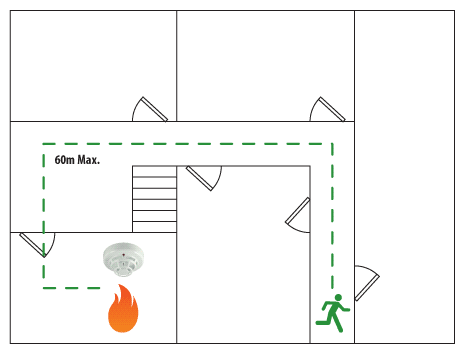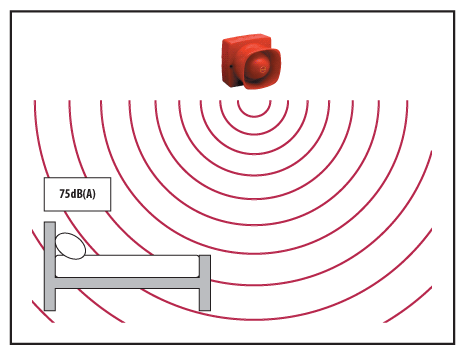Risk Assessment
The ‘Fire precautions (Workplace) Regulations’ require any business employing five or more persons to hold a written ‘Fire Risk Assessment’ and ‘Emergency Plan’. This must be periodically reviewed.
The local fire brigade can enforce compliance, and close any building that does not meet this act.
In the event of a fire in a building without a written ‘Fire Risk Assessment’, those responsible may face fines and imprisonment, and/or private litigation.
What the law requires you to do:
- Complete a fire risk assessment for your work place (considering all employees, the public, disabled people and people with special needs.
- Identify and record any significant finsings or persons at risk.
- Provide and maintain fire precautions.
- Provide information, instruction and training.
- Nominate persons responsible to implement your emergency plan.
- Consult employees about the above nominations and your proposals to improve fire precautions.
- Inform other employees who may have work places in the building about any significant risks which may affect their safety and co-operate with them to reduce/control these risks.
- If you are not an employer, but control premises which contain more than one workplace, you are responsible for complying with fire regulations.
- You must establish a suitable means of contacting the emergency services.
- Your employeees must co-operate to ensure the workplace is safe from fire and its effects.
System Zoning Information
In order to aid identification of the source of a possible fire, the protected building should be divided into ‘zones’. When deciding on a suitable zoning scheme for a building, consideration should be given to the size, any existing fire routines, escape routes, zone accessibility, and structural fire compartmentation.
The following guide lines should be observed:
- If the total floor area of the building is less than 300m2 then the building needs only one zone, regardless of the number of storeys.
If the total floor area is greater than 300m2:
- The maximum area for a zone is 2000m2
- If a stairwell (or similar) extends beyond one floor it should be a sperate zone.
- If a zone covers more than one fire compartment then the zone boundaries should follow the compartment boundaries.
- The search distance within the zone in order to ascertain the position of the fire should not exceed 60m. Remember that the use of Remote Indicator lamps may help to reduce the distance travelled.

- If a building is divided between occupiers, zones must not be shared between them.
Manual Call Points
A ‘Manual Call Point’ is a device which enables personnel to raise an alarm in the event of a fire incident by pressing a frangible element to activate the alarm system.
Manual Call Point should be installed at a height of 1.2m above floor level at easily accessible, conspicious positions, on exit routes, at the entry floor landings of staircases and at all exits to the open air.

Manual Call Points should be spaced so that one may always be found within a maximum distance of 45m apart or 25m for disabled person.

Automatic Detectors
When deciding on the type of detector to be used in any area it is important to remember that the detector has to discriminate between a genuine fire and the normal conditions existing therin.
Detector Information
Smoke Detectors
In open spaces under flat horizontal ceilings, every point should lie within 7.5m of a smoke detector.

Smoke dection should be generally avoided in the following areas to avoid unwanted alarms. They should be protected by means of other detectors such as heat detectors.
Contamination in dusty areas may cause unwanted alarms and reduce the life of the detector.
Damp or humid conditions such as showers, bathrooms and external areas should be avoided as the water vapour may cause unwanted alarms and reduce the life of the detector.
Detectors should never be used at low temperature where ice or condensation can affect detector sensitivity.
Kitchens, garages, welding shops and boiler houses should generally be avoided.
Heat Detectors General
In open spaces under flat horizontal ceilings, every point should lie within 5.3m of a heat detector.

Heat detectors are designed to either detect a rapid rise in temperature or to operate at a fixed temperature. Although they provide a slower response time than smoke detectors they do provide a method of protection for areas where smoke detectors cannot be used.
Heat detectors should not be used for the protecion of life or where extensive property loss may be expected.
‘Rate of Rise’ Heat Detectors
‘Rate of Rise’ heat detectors respond to both rapid increases of temperature and to fixed top temperatue.
‘Fixed Temperature’ Heat Detectors
Fixed temperature heat detectors are available with different temperature settings, and are normally installed in kitchens, boiler rooms, etc.
Detection In Apex Roofs
If the ceiling is pitched or sloping, smoke will tend to rise towards the highest point (apex) of the roof, therefore detection should be placed in the apex. As the slope tends to reduce the delay before smoke or heat reaches the detectors, it is permissable to use a greater spacing between the detectors mounted there.
Limits of Ceiling Height

Fire Alarm Sounders
Fire Alarm Sounders should be installed throughout the building with an even distribution, to generally provide a minimum sound level of 65dB(A) or 5dB(A) above any background noise which is likely to persist for more than 30 seconds.

Where the alarm may have to arouse sleeping persons e.g. Hotel bedrooms, nursing homes, etc, a minimum sound level of 75dB(A) is required, at the bed head with all the doors shut.

All fire alarm sounders in a building should produce the same sound, distinct from any other audible warning devices in the building.
Where fire alarm aounders are required in extremely noisy areas e.g. Machine shops, it may be necessary to install additional ‘Visual Indication Beacons’.
Cabling
The operation of a Fire Alarm and Detection System’ depends on the cabling and connections between the components. It is essential that connection between Manual Call Points and Detectors function correctly when they are operated.
Cables within the system are required to function correctly for significant periods after being attacked by fire. These include the power supply cables to the control panel, the detection circuits and the fire alarm sounder circuits. Thus the cables chosen must be correctly rated to withstand these conditions.






